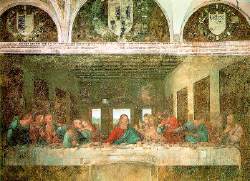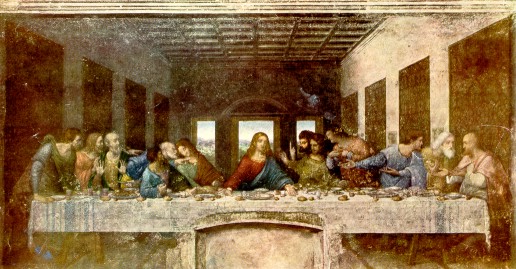
La Sainte Cène de Da Vinci - une histoire vraie
The Last Supper was painted by
Leonardo Da Vinci, a noted Italian artist;
and the time engaged for its completion
was seven years. The figures
representing the twelve Apostles and
Christ himself were painted from
living persons. The life-model for
the painting of the figure of Jesus
was chosen first.

When it was decided that Da Vinci
would paint this great picture,
hundreds and hundreds of young men were
carefully viewed, in an endeavor to find a
face and personality exhibiting innocence and beauty,
free from the scars
and signs of dissipation caused by sin.
Finally,
after weeks of laborious searching,
a
young man nineteen years of
age,
was selected as a model for the
portrayal
of Christ. For six months,
Da
Vinci worked on the reproduction
of
this leading character in his
famous
painting. During the next six years,
Da
Vinci continued his labors on
this
sublimework of art. One by one,
fitting
persons were chosen to represent
each
of the eleven Apostles; space being
left
for the painting of the figure
representing
Judas Iscariot, as the final
task
of this masterpiece. This was the
Apostle,
you remember, who betrayed his Lord
for
thirty pieces of silver, worth
$16.96
in our present day currency.

For
weeks, Da Vinci searched for a
man
with a hard callous face, with a
countenance
marked by scars of avarice,
deceit,
hypocrisy, and crime;
a
face that would delineate a character,
who
would betray his best friend.
After
many discouraging experiences,
in
searching for the type of person
required
to represent Judas, word
came
to Da Vinci that a man, whose
appearance
fully met his requirements,
had
been found in a dungeon in
Rome,
sentenced to die for a life of crime and murder.

Da
Vinci made the trip to Rome at once,
and
this man was brought out from
his
imprisonment in the dungeon
and
led out into the light of the sun.
There
Da Vinci saw before him a dark,
swarthy
man; his long, shaggy and unkempt
hair
sprawled over his face,
which
betrayed a character of viciousness
and
complete ruin. At last, the famous
painter
had found the person he
wanted
to represent the character
of
Judas in his painting.
By
special permission from the king,
this
prisoner was carried to Milan
where
the picture was being painted;
and
for months he sat before Da Vinci at
appointed
hours each day, as the
gifted
artist diligently continued his
task
of transmitting to his painting
this
base character in the picture
representing
the traitor and betrayer of our saviour.
As
he finished his last stroke, he
turned
to the guards and said,
"I
have finished. You may take the prisoner away."

As
the guards were leading their prisoner away,
he
suddenly broke loose
from
their control and rushed up to Da Vinci,
crying
as he did so,
"Oh,
Da Vinci, look at me!
Do
you not know who I am?"
Da
Vinci, with the trained eyes of a great
character
student, carefully
scrutinized
the man, upon whose
face
he had constantly gazed for six
months
and replied,
"No,
I had never seen you in my life,
until
you were rought before me
out
of the dungeon in Rome."
Then,
lifting his eyes toward heaven,
the
prisoner said,
"Oh,
God, have I fallen so low?"
Then
turning toward the painter he cried,
"Leonardo
Da Vinci!
Look
at me again, for I am the same man
you
painted just seven years ago
as
the figure of Christ."

Many
lessons can be learned from this
true
story of the painting of
The
Last Supper. This is a story of how we
often
perceive others - how
easily
we overlook the Christ within
the
people we meet, and judge by
outward
appearances. This also strongly
teaches
the lesson of the
effects
of right or wrong thinking, on the life of
an
individual. Here was a young man whose
character
was so pure and
unspoiled
by the sins of the world, that he
presented
a countenance of
innocence
and beauty fit to be used for
the
painting of a representation of Christ.
But
within seven years, following the thoughts of sin and a
life
of crime, he was changed into a
perfect
picture of the most traitorous
character
ever known in the history of the world

Next?....Suivant?